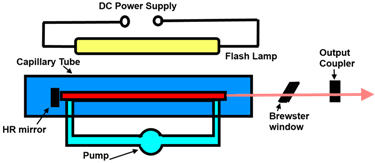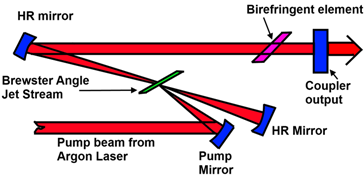Dye Laser (A Liquid Laser)
The Dye Laser is a Liquid Laser. Liquid lasers are those lasers which uses liquid as an active medium.
In dye laser the liquid material called dye (for example rhodamine B, sodium fluoresein and rhodamie 6G) uses as an active medium, which causes to produce laser light.
Characteristics of Dye Lasers
The dye lasers produce output whose wavelengths are in the visible, ultra violet and near infrared spectrum. Which usually depending on the dye used wave lengths therefore vary from 390 to 1000nm.
The output power of dye lasers can be considered to start from 1 watt with no theoretical upward limit. The output beam diameter is typically 0.5mm and the beam divergence is from 0.8 to 2 milli radians. The conversion efficiency of the light from the pumping source to an output from the dye laser si relatively high approximately 25%.
Construction of Dye Liquid Lasers
The dye lasers can be constructed in two possible ways, according to their pumping methods. The 1st configuration can be shown as

In the shown configuration, the dye is pumped through the capillary tube from a storage tank. While in capillary tubes it is optically excited by flash lamp. The output of the laser passes through a Brewster window to the output coupler which is 50% reflective mirror.
The 2nd configuration can be shown as

In this shown configuration, the dye is pumped through the nozzle at high speed to form a Brewster angle jet stream. The excitation mechanism for this laser is a second laser (e.g. argon laser). The laser beam reflected from two HR (high Reflective) mirrors to the output coupler again the output coupler is about 50% reflective. The birefringent filter/element is used to tune the laser to one of a given range of frequencies.
Working / Function of Dye Lasers
We know that active medium used in a dye laser can be one of organic dyes. The medium is dissolved in a solvent such as water, alcohol or ethylene glycol.
The organic dyes such as rhodamine B, sodium fluorsin for example chemical formula for one of these dyes rhodamine-B is c28H31. It is therefore very difficult to determine the element that actually lases. For this reason we will simply say that some organic dye will lase.
Note that the organic dye laser produces a range of wavelengths. For example rhodamine-B produces wavelengths in the 590nm to 660nm range. However the amount of amplification varies across the range of frequencies, with max output at about 618nm.
By using the birefringent filter, it is possible to tube the laser to specific output frequency. This filter bends the different wavelengths much the same as a prism but to as much greater extent. This makes it possible to tube the laser with great deal of accuracy.
Application of Dye Lasers
- Dye lasers are mostly used as a research tool in medical applications
Advantages of Dye Lasers
- It is available in visible form (also in non-visible)
- Range of wavelengths can be produced by the using dye lasers.
- Beam diameter is very less.
- Its beam divergence (0.8 milli radians to 2 milli radians) is also less from many lasers beam divergence.
- Construction of dye laser is not so complex.
- Having the greater efficiency 25%.
- High output power is also possible with dye lasers
Disadvantages of Dye Lasers
- Cost of dye lasers is very high.
- Some cases need other laser beam.
- To tune at one frequency, the laser uses birefringent element or filter making it more costly.
- In dye lasers it is very difficult to determine the element that actually lases because dye has complex chemical formula.
